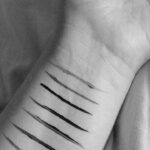The teenage years are known to be some of the most challenging and difficult years of our lives. With hormonal and
Self-harm noted in this article, is harm to one’s self that is intentional but without purpose to die. Typically, teens may harm themselves on accident in many different ways. For example, they may be clumsy, they try a new “trick” on their skateboard, be goofing around, and many other incidences. Intentional self-harm, however, is done to inflict some type of pain on themselves.
Girls more so than boys are prone to self-injury. A 2015 CDC study found an estimated 17%-30% of girls while 6%-14% of boys intentionally hurt themselves. These acts of harm may be a one-time or rare act, inconsistent, impulsive, random, or habitual in nature. So, let’s look at what it is, why teens (and younger) purposefully harm themselves, signs to look for, and interventions.
Self-harm: What is it?

Why do teens self-harm?
The “why” varies among each of the teens as well as in the context of their lives, relationships, and situations. With the list that
o Cry for help (a necessary need for seeking support)

~Boredom or emotional flatness (“I just want to feel something”)
~Numb the intense negative feelings
~Relief or distraction from distressing feelings
o A deep struggle with depression
o Self-punishment
o Feel a sense of control
o Poor sleep/poor physical health regulation combined with social media and emotional overload
o Coping with or reliving of past trauma or abuse (externalizing internal wounds)
o Troubling times
o Anxious society
~Bullying (in person and online (cyber bullying))
~Media — Social media, movies, digital games, and video influencers
o Normalized behavior (in certain circles of influence)
What to look for…signs of self-harm
As we have seen, self-harm may be hard to detect. Many teens have learned how to hide, avoid detection, and cover it up through many different ways. However, when we as parents become more aware of the signs we will seek to intervene for their safety and well-being. As a parent does more observation, communicating love, genuine concern and care, this will do more to improve the relationship.

• Unexplained (or poorly understood) scars
• Scabs
• Ongoing cuts, scratches, burns, or other physical injuries
• “Excuses” or unrealistic explanations as to why the wounds
• Wearing of long pants and long sleeves even in hot weather
• Avoidance of touch (on certain areas)
• Sensitive to touch
• Signs of blood (whether on sheets, wash cloths, towels or clothes or unexpectedly doing their own laundry
• Dumping out his/her own trash
• Asking for razors or fixation with knives or sharp objects
• Lack of desire to seek out friendships
• A steady withdrawal from friends, family, or social activities
• Isolation or “hibernation” from others at home
• Extended periods of time on social media (and other types of media)
• Talk of others not caring
• Ongoing negative self-talk. Such as, “I’m pathetic”, “I’m a loser”, “I suck at everything”, “everybody hates me”, and other such comments.
The occurrence of these signs may appear to be moderately consistent or may appear random. They will generally be an outward sign of changes your teen is experiencing. These experiences may be at home, at school or in social interactions whether in person or online.
Interventions
To be clear: self-harming behavior is to be taken seriously. Be concerned yet not over bearing. Interventions require vigilance, understanding, planning, as well as consistent action. Reflect on the love, care and concern you have for your child.
Discovering that your teen has harmed herself / himself can be a bit alarming and disturbing. You may feel angry, shock, overly anxious, or sad. These feelings are real. They are yours. Note, it is important to remember that your teen may have or had most if not all of these feelings at some point. Thus, be compassionate and empathetic.
 Take initiative…
Take initiative…
…to listen to your child. See him/her as valuable and worthy of being understood. Communicate your concern for her. Let him know you are available, and make yourself available. Ask for her to be a part of dinner planning, family activities, and the like. Many times parents become too busy in their own issues, jobs, or household responsibilities to be available for their teenager. Don’t be intimidated by their antics or avoidant behavior.
Be aware…
…of your teen’s mood. Take into account the what, why and signs listed earlier in this article. Be intentional yourself in connecting with your teen. Be genuine and consistent in finding out the truth. This may be difficult yet be patient, calm yet persistent when discussing self-harm. Show you care for their safety. Determine if they are wanting to end their life now and if “yes” in the moment get emergency help by calling 9 1 1.
Limit social media or “screen time” yet be sure they have another safe, clear activity or duty to do.
Once you call her out from the self-harm, be sure that he / she is in eye-sight of you. Sit down together and write out a clear, simple safety plan (this may be more addressed in counseling with a counselor).
Take safety at home seriously. Be aware of household medications, matches, knives, and other sharp objects that are easily accessible in the home. Lock them up as much as possible.
Seek…
…professional intervention and support from a counselor for your teen. Generally, self-harm is often an indicator of more serious mental health issues, which may require more support than once-weekly talk therapy can provide.
Seek help from another trusted adult as well as from a counselor. Show support in taking your teen to a therapist whom they will align with and be able to share their feelings with.
We here with Pathways Counseling Services are here to help. We have counselors available for your teen, pre-teen, child. Together, we can work through these troubling times.
To learn more about Teen Counseling, click here
Please call us at 520-292-9750 or email us at jo**@************on.com


 Take initiative…
Take initiative…



